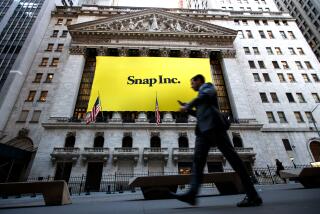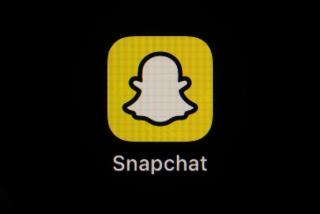Snap Inc. announces two big hires ahead of its critical third-quarter earnings report

Snap Inc. announced Wednesday that it is hiring two new executives to take on the responsibilities of former chief strategy officer Imran Khan — including a major hire from Amazon that could help the struggling social media company expand its user base and turn toward profitability.
The hires came just one day before the company was set to release its third-quarter earnings statement amid a long decline of its share price, from $20.75 in February to under $7 this last week. The company’s stock price rose on the news before ending the day down 3% at $6.59.
When Khan left Snap in early September, the company announced that his replacement would have the new title of chief business officer. With Wednesday’s hires, the company is effectively splitting Khan’s former role into two new positions — one focused on sales and marketing, the other on global user growth.
Jeremi Gorman is leaving her job as chief of global advertising sales at Amazon to become Snap’s new chief business officer, and Jared Grusd, who was chief executive of the Huffington Post, is joining as chief strategy officer, Chief Executive Evan Spiegel said in a note to employees.
At Amazon, Gorman was instrumental in turning the tech behemoth into one of the largest online ad publishers, after Facebook and Google, with ad revenues topping $2 billion in the first quarter of this year.
“Jeremi joins us with proven expertise and talent that will make our platform even better for our partners and I am excited to have her on our team,” Spiegel wrote in his note.
But as Snap prepared to release its earnings report on Thursday, analysts were split on a central question facing the company: Is Snap a Twitter, or a Myspace?
Twitter, despite facing public scrutiny over its management of offensive content and fake users, has added 3 million to 6 million new users in recent quarters and produced its first-ever profit at the beginning of this year.
For analysts who see Snap following this mold, a dip in user growth isn’t terminal — but the company needs to monetize all those eyeballs.
Myspace dwindled to insignificance after its users left the early social network in favor of Facebook. For analysts in this camp, Snap needs to make a better product that draws more users in to stay valuable to investors, or it is doomed.
Michael Pachter, an analyst at Wedbush Securities, is on the optimistic side of the divide.
“I don’t think most investors have teenage kids,” Pachter said. Facebook’s Instagram app has around 500 million daily active users, to Snapchat’s 188 million. But Snap skews much younger: 70% of its users are under 25, while 75% of Instagram’s users are over 30. “Younger users’ network is on Snapchat; they’re not going to move over. If Snap gets serious about making money, they can turn things around.”
Pachter sees Wednesday’s hires as a sign that Snap is doing just that.
“Replacing a Mattel CFO and a stock market analyst with the head of Amazon ad sales and a seasoned internet executive says they’re serious about profitability,” Pachter said, referring to former Chief Financial Officer Drew Vollero and Khan. “It speaks volumes about Spiegel and his willingness to take investors seriously.”
Snap has faced major headwinds since it redesigned Snapchat late last year following longstanding criticism that the app was too hard to navigate. But the changes didn’t go over well, even sparking a Change.org petition with 1.2 million signatories.
In May, Snap tweaked the redesign and put content back into reverse-chronological order, as it had been since Snapchat first went live. The damage was done, however. Snap reported its first decline in daily active users when it released its second-quarter financial results in August, adding to fears that Facebook had successfully stolen Snapchat’s thunder by copying its core features with its Instagram Stories product.
Richard Greenfield from BTIG Research says the user dip points to the stark challenge facing Snap. “The company has to make the product start gaining users and time spent,” Greenfield said. “Anything else is a sideshow.”
He sees the Twitter comparison as a red herring.
“Twitter has dramatically increasing [user numbers] and increasing time spent,” Greenfield said. “I don’t think there’s anything in the earnings results themselves that could change my outlook. They need to acknowledge there’s a product problem.”
Snap has seen a string of high-profile departures since its 2017 initial public offering.
Vollero departed in May and was replaced by Amazon.com Inc. veteran Tim Stone. Snap’s vice president of product, Tom Conrad, also left earlier this year. Conrad, who was reportedly one of Spiegel’s closest lieutenants, told the publication TechCrunch that he was planning to leave the tech industry altogether. And Steve LaBella, Snap’s vice president of marketing, is set to exit at the end of November.
None of the departures, however, were more significant than Khan’s. He had played an instrumental role in Snap’s IPO and led the company’s transition to a more lucrative automated advertising business model.
Sources at the time said Khan, who came to Snap after working as an analyst at Credit Suisse, was leaving to start his own technology investment firm.
Under his watch, Snap grew from just a few dozen employees to more than 3,000, operating in 13 countries. In 2016, Khan’s compensation totaled $5.5 million, according to a filing made with the Securities and Exchange Commission last year ahead of Snap’s IPO.
Snap says the turnover is not reflective of a company in chaos, but rather the regular churn of a young firm finding its footing.
Analysts do seem to agree on one thing: With forecasts for its stock price ranging from $5 on the bear end to $16 on the bull, Snap is unlikely to return to its $17 IPO price — let alone the $24 heights the shares reached in their first day of trading — anytime soon.
Twitter: @samaugustdean
UPDATES:
4:20 p.m.: This article was updated with additional analysis and the stock market closing.
This article was originally published at 10:35 a.m.







